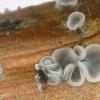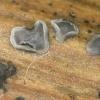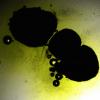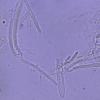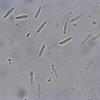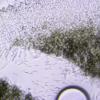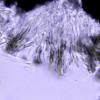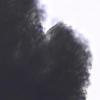
21-11-2025 11:52
Jean-Luc RangerBonjour à tous, on voit toujours 2 espèces areni

21-11-2025 11:51
Jean-Luc RangerBonjour à tous, on voit toujours 2 espèces areni

21-11-2025 11:51
Jean-Luc RangerBonjour à tous, on voit toujours 2 espèces areni

21-11-2025 10:56
 Christopher Engelhardt
Christopher Engelhardt
Very small (~0,5 mm) white ascos, found yesterday

14-11-2025 16:26
 Marian Jagers
Marian Jagers
Hello everyone, On dead wood of Cytisus scoparius

17-11-2025 21:46
Philippe PELLICIERBonjour,Récolté sur bois pourrissant de feuillu

20-11-2025 14:14
Mick PeerdemanFound on the leaves of 'Juglans regia' in the Neth
 Hi,
Hi,Found in March on last years stick from Rubus idaeus, Denmark.
Apotecia: Do not seem to be erumpent, sessile, smooth grey disk, with anchoring hyphae, bright yellow colour extracted with KOH.
Asci: IKI+, I think with croziers, approx. 53 (40-55) x 5-5,5 my.
Ascospores: 1-celled, mostly clavate, 10,2 (8,3-12,4) x 2,1 (1,7-2,5) my, Q=4,9 , n=20. With some droplets.
Paraphyses: Cylindrical, 3 my wide, with large light diffracting LBs.
Excipulum: Mostly roundish dark cells, some dark hairlike cells seen.
Any help much appreciated.
Kind Regards
Mathias

Yours, Lothar


Hier kannst Du wertvolle Infos lesen:
https://asco-sonneberg.de/pages/gallery/mollisia-revincta-epilobium-koh-110910-01xs21751.php
Dort steht u.a. auch:
Auf die KOH-Reaktion kann man sich wahrscheinlich nicht gut verlassen. Zwar ist sie meist mittelstark und vergänglich, jedoch sind mir von Rubus auch stark gelbe und anhaltende Reaktionen bekannt
Dein Fund ist ja von Rubus.



Yours, Lothar



Mollisia revincta is a complex of species with small spores on herbaceous stems. According to my own collections there are quite many genetically different species which I used to "determine" as revincta. There are collections with strong and with weak yellow reaction and even without. I did not study that complex ion detail, but I'm convined that Mollisia clavata is a different species characterized by the marginal cells. What concerns Mollisia alcalireagens, there is the problem that the i examined the holotype collection PRM899458 and found it to be completely KOH-negative (also NH3-negative). I don't know how to interprete this. On the other hand I have collections from Rubus which are strng yellow whereas collections from Filipendula (which I think to be the "true" revincta" are usually only weakly positive.
No great information all in all, I know. That group needs revision ....
all the best,
Andreas


